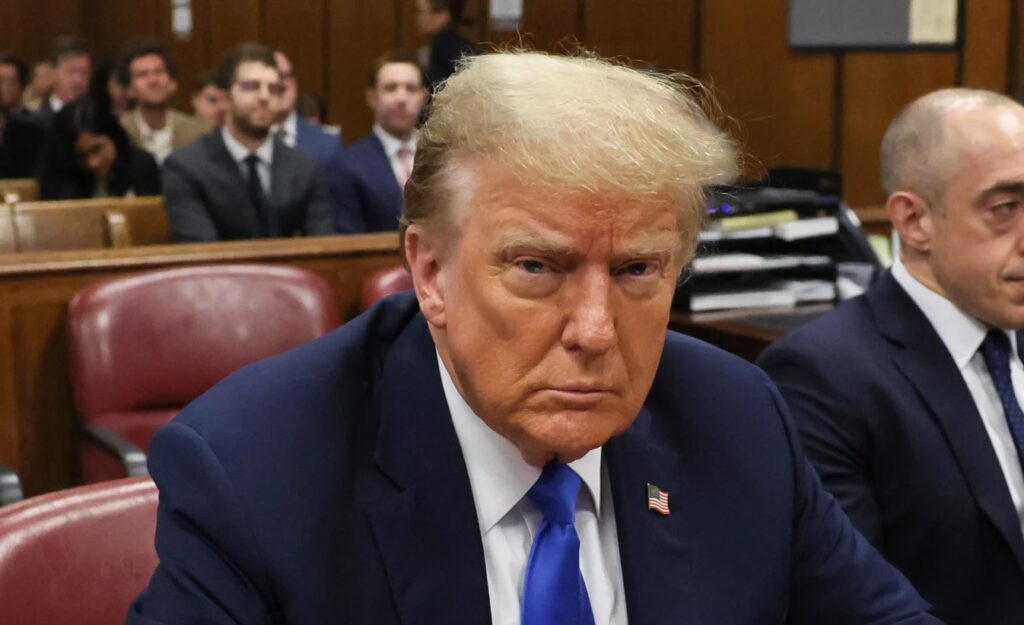How would Project 2025 affect Native communities?

Republican presidential candidate and former President Donald Trump sits in the courtroom at his criminal trial at Manhattan state court in New York, Monday, April 22, 2024. (Brendan McDermid/Pool Photo via AP)
Besides promising federal recognition to the Lumbee Tribe in North Carolina, Trump’s campaign has not established a solid plan for Indian Country. However, Project 2025, a nearly 1,000-page book, does have some rough ideas for Indian Country.
While the president-elect has publicly distanced himself from the conservative think tank Heritage Foundation’s highly controversial Project 2025, the project was written by many of his former staffers as a road map for Trump.
A majority of the plan relating to Indian Country focuses heavily on resource extraction, critiquing President Joe Biden’s initiatives over the past four years, particularly in terms of his push for electric vehicles, reduced fossil fuels and climate change initiatives.
Aside from land management and mining, the report briefly outlines the desire to reform Indian Health Services, the Bureau of Indian Education and crime in Indian Country.
Chase Iron Eyes, director and lead counsel for the Lakota People’s Law Project, said the Heritage Foundation and other Christian fundamentalist organizations have attempted to strip tribes of their sovereignty.
“The source of the attacks and the vitriol and the attempted usurpation of our rights, our human rights, our constitutional rights, our treaty rights, that is the Heritage Foundation,” he said recently on Instagram. “Their ultimate goal is to assimilate all Indigenous nations. That is why we’re called Indigenous peoples because they want to deny to us our nationhood.”
Land
The Department of the Interior plan, written by Trump’s former acting head of the Bureau of Land Management, William Perry Pendley, and assisted by former Principal Deputy Assistant Secretary in Indian Affairs, John Tahsuda (Kiowa), outlines growth potentials for gas, oil and mineral extraction.
A majority of the plan’s details related to Indian Country come in the Department of the Interior section.
In this section, the project advises Trump to immediately roll back Biden’s orders reinstating his previous energy agenda and that he withdraw bans on oil and gas leasing around the Chaco Cultural Historic National Park in New Mexico.
The plan also recommends Trump reinstate orders to work on the National Petroleum Reserve in Alaska, which Alaska Natives have long raised concern over and tried to work with Biden to protect in 2024.
The project recommends Trump approve the 2020 Willow EIS pipeline, the largest pending oil and gas projection in the United States within the National Petroleum Preserve in Alaska. This plan would expand approval from three to five drilling pads.
The 2025 Project critiques Biden’s naming of several locations as national monuments and requests that Trump repeal the Antiquities
Act of 1906 and retroactively remove already established site protections. This act was initially created to address the theft of Native artifacts on federal land.
The report claims the Biden administration has reversed efforts to put Native nations in charge of environmental regulations on tribal land. This appears to be in reference to the project’s suggestion that Biden’s focus on clean energy has negatively impacted tribes and limited their ability to mine fossil fuels.
Finally, the project requests that the new administration seek congressional reauthorization of the Land Buy-Back Program for Tribal Nations and provide a $1.9 billion Trust Land Consolidation Fund to purchase fractional interests in trust or restricted land from willing sellers at fair market value. Funds would come from the Great American Outdoors Act.
Health
Project 2025 calls for reforming the Indian Health Services, the primary healthcare provider for Indigenous people. The project critiques IHS’s handling of the COVID-19 pandemic in Indigenous communities, stating that IHS “abandoned tribes as their sources of COVID-19 tests and vaccine supplies disappeared.”
Instead, the project suggests that tribal communities rely on alternatives to IHS through better access to private healthcare providers. The project suggests this could be done by exploring previous veteran healthcare reforms.
A report released by Senate Democrats states that changing IHS to focus more on privatized services would “destroy Indian Health Services.”
Education
In general, Project 2025 seeks to eliminate Head Start programs, which over 28,000 Native children use.
In terms of Indian Education, the project suggests all federal Indian Education programs be transferred to the Bureau of Indian Education, as well as tribal postsecondary career and technical programs, to reduce “bloat” and streamline services.
Currently, tribes can either contract with the Bureau of Indian Education to provide educational services, or the bureau manages schools on tribal land.
“Schools on tribal lands and under the auspices of the Bureau of Indian Education (BIE) are among the worst-performing public schools in the country,” page 348 of Project 2025 reads.
Aside from this, the report doesn’t offer much of a plan for what an Indian Education reform would look like.
Crime
The report offers little in terms of reprieve for high rates of Missing and Murdered Indigenous Women. It does, however, claim that the Biden administration’s handling of the southern border has led to a tide of illegal drugs, particularly fentanyl, entering Indian Country.
The project notes that a majority of this activity occurs in southern tribal communities. In 2024, conservatives such as South Dakota Gov. Kristi Noem made national news when she began to claim cartels had infiltrated reservations in South Dakota.
The project does not make any recommendations for increasing law enforcement in Indian Country.
The post How would Project 2025 affect Native communities? first appeared on Native Sun News Today.
Tags: Top News
